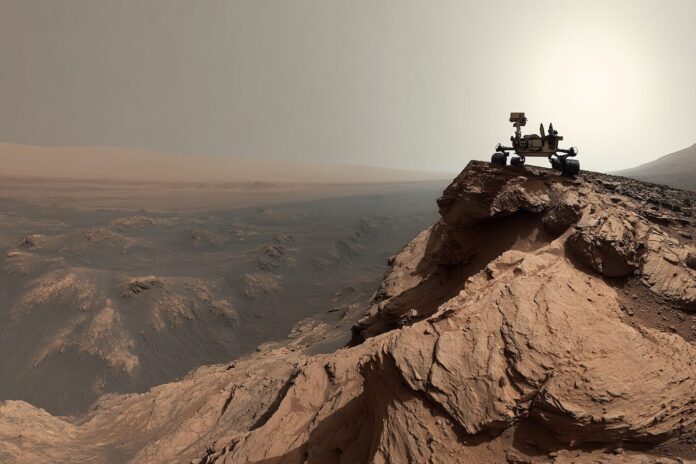Exploring the Crest: New Perspectives from Mars
On July 17, 2025, NASA’s Curiosity rover achieved a significant milestone by reaching a strategically important location. After a deliberate drive to site 117.2490, the rover parked at the edge of a robust, erosion-resistant Martian ridge. Most importantly, this triumph during sols 4602-4603 not only exemplifies impressive navigation and hazard avoidance but also opens new windows into Mars’ ancient geologic records. Because the rover’s journey is filled with scientific potential, every sol brings us closer to deciphering the Red Planet’s complex history.
Moreover, the new vantage offers a dual perspective, capturing both wide panoramic vistas and detailed close-ups of the ridge’s structure. Therefore, this achievement stands as a testament to the well-coordinated efforts behind Curiosity’s mission and its ongoing exploration of Mars. In addition, the successful stationing at this outcrop has enhanced our ability to observe atmospheric, sedimentary, and erosional processes in unprecedented detail.
The Geological Significance of Martian Ridges
Martian ridges like this one offer scientists invaluable insights. Because these elevated structures often form due to interactions with ancient water flows, they capture a history that spans billions of years. Transitioning from broad environmental transformations to the deposition of mineral layers, water once played a vital role. Most importantly, when water interacts with rock, it often leads to cementation that makes these formations exceptionally resistant to erosion.
Besides that, examining the ridge’s structure provides clues about past climates and the environmental conditions that prevailed on Mars. The detailed stratigraphy observed at the ridge, where sedimentary layers tell tales of water-driven deposition, has ignited further discussions among planetary geologists. Consequently, decoding these layers may reveal whether water acted alone or in conjunction with other geological processes to shape Mars’ current landscape. For further insights, readers may refer to detailed analyses provided by NASA’s Curiosity Blog.
Curiosity’s Tactical Approach to the Ridge
Because the mission team meticulously planned every move, Curiosity’s drive to the ridge was as much about strategy as it was about exploration. The rover’s navigational maneuvers allowed it to secure both panoramic and granular perspectives of the Martian surface, enabling scientists to glean maximum scientific returns. Most notably, the Hazard Avoidance Camera (HazCam) provided crucial imagery confirming the safety of the rover at the ridge’s precipice.
Transitioning seamlessly from wide-field views to high-resolution observations, the rover now captures intricate details of the surface geology. This data not only documents the ridge’s physical structure but also highlights variations in mineral composition and erosional features. For those interested in further background, additional perspectives can be found on Lemmy World and Space.com.
Implications for Mars’ Hydrologic History
Water is a key player in understanding Mars’ past, and this ridge symbolizes its historical impact. Because water once flowed across the planet’s surface, its interactions with minerals led to the creation of hard, resilient outcrops. Therefore, every sediment layer captured by Curiosity holds potential clues about the ancient water-driven processes that have long since faded into history.
In addition to providing evidence of water activity, the ridge’s structure may help scientists answer critical questions: Was Mars dominated exclusively by hydrological influences, or did volcanic and other processes also leave their mark? Most importantly, scrutinizing such features could enhance our comprehension of how and why Mars transitioned from a potentially habitable world to its current arid state. Detailed observations such as these are discussed further on NASA’s official Curiosity Blog.
Advanced Imaging and Data Collection Methods
Because every image from Curiosity is invaluable, the rover’s advanced imaging systems are prominently at work during these sols. The combination of Mastcam mosaics and HazCam imagery provides an exceptional opportunity to study the ridge’s complex interlayered structures. Consequently, planetary geologists can detect subtle variances in sediment deposition and crust formation that might otherwise remain elusive.
Additionally, special attention is given to transition zones where erosion patterns begin to emerge. For example, changes in mineral texture and color often mark boundaries between different depositional environments. Thus, each carefully captured image contributes to a richer and more detailed understanding of Mars’ geologic evolution.
Future Directions and the Broader Impact of These Discoveries
Most importantly, the data collected from the ridge’s crest is not an endpoint but a stepping stone toward future exploration. By meticulously examining the rock formations and sedimentary layers, scientists are better equipped to map the geologic history of Mars. This information is crucial for designing future missions and for potentially identifying areas where past life may have thrived.
Because every new vantage point broadens our understanding, the information from these sols sets the stage for subsequent investigations. The detailed imagery and geologic data serve as benchmarks for further comparisons across diverse Martian terrains. Therefore, the continuous accumulation of data reinforces the overall mission’s significance and underscores its contribution towards answering the age-old question of Mars’ habitability.
Expanding Human Understanding of Mars
In conclusion, Curiosity’s ascent to the ridge is more than a routine maneuver; it is a moment of discovery and a leap forward in our understanding of Mars’ dynamic past. By venturing into challenging terrains and engaging in meticulous data collection, the rover paves the way for future interplanetary exploration and research. Most notably, each rock, layer, and image from the ridge serves as a chapter in the ongoing story of Mars.
For more detailed narratives and continuous updates on Curiosity’s journey, readers are encouraged to explore the referenced articles and official NASA blogs. Because these sources offer deeper scientific context, they enhance our collective understanding and fuel the passion for space exploration.



